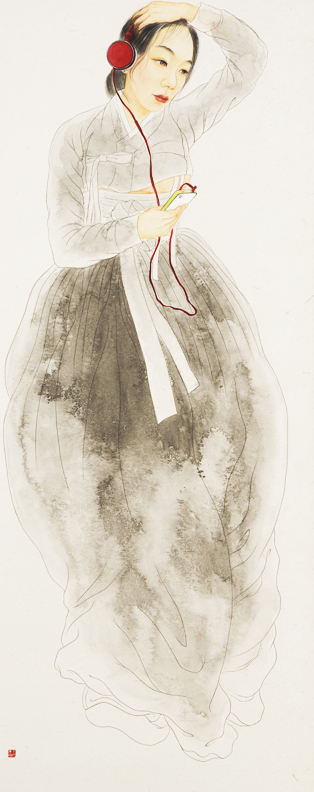
Dong Yeoun Lee's series of female portraits features standing and sitting young women in traditional Korean dress who display a range of technological devices. Although the scroll paintings elicit a definite Asian sensibility (oriental coloring on oriental paper), they are reminiscent of the art of Thomas Gainsborough who produced sympathetic portraits of female subjects, which penetrated their social "masks" to reveal the truth of their character. Lee’s works are shorn of site-specific ornamentation; they hone the essence of solitary or dual figures situated on empty formats, which accentuate their faces and poses.
The young women exist in isolation within the confines of the vertical design as they quietly assert their presence. The figure in "Clear Girl" displays a contemplative smile, mysterious and inward, not unlike a "Mona Lisa" smile in its enigmatic purity and elusiveness. The girl in "Redefining Contemporary Beauty 5" (2012) dresses traditionally but her preoccupations appear to be thoroughly modern as she listens, presumably, to music with headsets, wears a digital watch and seems to be using a Bluetooth device with her cell phone. Her Hanbok garment signifies the ability to participate in the customs of historical eras as well as present day trends. The girl's modest reserved demeanor might suggest that she is "old-fashioned" apart from her display and use of contemporary devices. The subjects are out to communicate on whatever level they are functioning on at the present moment.
The communication tools infuse a narrative element into several of the works; the females in "Redefining Contemporary Beauty 1," and "Redefining Contemporary Beauty 5" convey the impression that they experience no strife or conflicts, but accept the intersection of past and present, navigating diverse cultural expectations in a hybrid life.
The blank activates the figures, highlighting them in the soft cream-colored format. The pictures are muted and neutral, enabling the viewer to appreciate the delicate smiles and inner energy that brings to life the figures’ facial features and personal feelings. The subjects in "Clear Girl" (2017) and in "Bright Girl, Smiling Girl" (2017) seem secure in a serene world of contemplation, where validation or approval from others is irrelevant. The artist establishes and preserves a mysterious private vision that defies easy labels or generalizations.
In her artist statement, Lee reveals that she is acutely aware of the "other," but in order to create a life that suits her unique personality, she resists social conformity. The natural desire to belong socially is strong. In this series the artist asserts her need to express herself without courting social ostracism, conscious of others' limits to the acceptance of divergence. Lee searches for her true inner self with the freedom that negates the desire to please or be like her peers. In her philosophical quests she attempts to unearth the nature of existence as it relates to the self and to the being of others. She realizes that to gain a true picture of herself is an impossible goal, as we can never see ourselves as other people see us. Our mirror image is reversed and distorted, so we cannot see ourselves as we truly appear.
Lee views all her art as self-portraits, composites of her essential being with the beings of others. The artist seems to adhere to the Asian precept that in order to discover ones personal discourse, one must investigate the relationship of past to present. In her quest for reality she redefines beauty by adopting customs from past ages into the present as a means to reconcile her "deficiencies." Lee's awareness of her character deficits stirs a sense of loneliness that focuses on longing for her former beauty and youth. Lee regrets the shallow nature of ostensible communication through social media, which she believes accentuates and generates feelings of estrangement. She has created unfathomable images of solitary girls who, despite their use of social media, maintain their separateness while in search of themselves.
